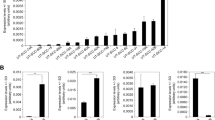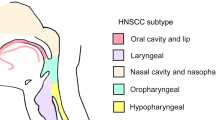Abstract
The suppressors of cytokine signaling (SOCS) are inhibitors of cytokine signaling that function via the Janus kinase (JAK)/signal transducers and activators of transcription (STAT) pathway. Recently, methylation of SOCS-1 and SOCS-3 has been implicated in the tumorigenesis of liver and lung cancer. This study was performed to elucidate the role of SOCS-1 and SOCS-3 in squamous cell carcinoma of the head and neck (HNSCC) and its precursor lesions. HNSCC of 94 patients and corresponding normal mucosa, lymph node metastases as well as 16 high- and 21 low-grade squamous cell dysplasias were studied by using methylation-specific PCR (MSP) for the SOCS-1 and SOCS-3 promoter after microdissection. The presence of SOCS-3 mRNA transcripts was confirmed by semiquantitative real-time PCR, and the SOCS-3 protein was analysed immunohistochemically. SOCS-3 hypermethylation was found in 85/94 HNSCC (90%) and in 10/16 high-grade and 9/21 low-grade dysplasias (63 and 43%, respectively). SOCS-1 promoter hypermethylation was detected in 10/94 HNSCC samples (11%) and in 2/16 high-grade and 1/21 low-grade dysplasias (13 and 5%, respectively). Lymph node metastases exhibited an identical methylation status as the primary tumors. Methylation of the SOCS-3 promoter correlated with downregulation of SOCS-3 transcripts and protein expression in these tumors and various cell lines. In the cell lines tested, SOCS-3 and SOCS-1 transcripts increased upon treatment with the demethylation compound 5-aza-2-deoxycytidine (5-AZA-DC). Overexpression of wild-type SOCS-3 in carcinoma cells with methylated SOCS-3 resulted in the induction of apoptosis and growth suppression as well as downregulation of STAT3, bcl-2 as well as bcl-xL. Our data suggest that promoter methylation and subsequent transcript downregulation of SOCS-3 transcripts and, to a much lesser extent, SOCS-1 are involved in the multistep carcinogenesis of HNSCC. During its involvement in tumor growth, restoration of SOCS-3 may hold treatment potential for HNSCC.
This is a preview of subscription content, access via your institution
Access options
Subscribe to this journal
Receive 50 print issues and online access
$259.00 per year
only $5.18 per issue
Buy this article
- Purchase on Springer Link
- Instant access to full article PDF
Prices may be subject to local taxes which are calculated during checkout







Similar content being viewed by others
Abbreviations
- HNSCC:
-
head and neck squamous cell carcinoma
- SOCS:
-
suppressor of cytokine signaling
- STAT:
-
signal transducer and activator of transcription
- JAK:
-
Janus kinase
References
Ali S, Nouhi Z, Chughtai N and Ali SJ . (2003). Biol. Chem., 278, 52021–52031.
Bowman T, Garcia R, Turkson J and Jove R . (2000). Oncogene, 19, 2474–2488.
Cacalano NA, Sanden D and Johnston JA . (2001). Nat. Cell Biol., 3, 460–465.
De Vos J, Jourdan M, Tarte K, Jasmin C and Klein B . (2000). Br. J. Haematol., 109, 823–828.
Esteller M . (2002). Oncogene, 21, 5427–5440.
Forastiere A, Koch W, Trotti A and Sidransky D . (2001). N. Engl. J. Med., 345, 1890–1900.
Fukushima N, Sato N, Sahin F, Su GH, Hruban RH and Goggins M . (2003). Br. J. Cancer., 89, 338–343.
Galm O, Yoshikawa H, Esteller M, Osieka R and Herman JG . (2003). Blood, 101, 2784–2788.
Grandis JR, Drenning SD, Zeng Q, Watkins SC, Melhem MF, Endo S, Johnson DE, Huang L, He Y and Kim JD . (2000). Proc. Natl. Acad. Sci. USA, 97, 4227–4232.
He B, You L, Uematsu K, Zang K, Xu Z, Lee AY, Costello JF, McCormick F and Jablons DM . (2003). Proc. Natl. Acad. Sci. USA, 100, 14133–14138.
Herman JG and Baylin SB . (2003). N. Engl. J. Med., 349, 2042–2054.
Herman JG, Graff JR, Myohanen S, Nelkin BD and Baylin SB . (1996). Proc. Natl. Acad. Sci. USA, 93, 9821–9826.
Larsen L and Röpke C . (2002). APMIS, 110, 833–844.
Levy DE and Gilliland DG . (2000). Oncogene, 19, 2505–2510.
Lin SY, Yeh KT, Chen WT, Chen HC, Chen ST, Chiou HY and Chang JG . (2004). Oncol. Rep., 11, 341–348.
Melzner I and Möller P . (2003). Blood, 102, 1554–1555.
Mora LB, Buettner R, Seigne J, Diaz J, Ahmad N, Garcia R, Bowman T, Falcone R, Fairclough R, Cantor A, Muro-Cacho C, Livingston S, Karras J, Pow-Sang J and Jove R . (2002). Cancer Res., 62, 6659–6666.
Nagai H, Kim YS, Konishi N, Baba M, Kubota T, Yoshimura A and Emi M . (2002). Cancer Lett., 186, 59–65.
Nagai H, Naka T, Terada Y, Komazaki T, Yabe A, Jin E, Kawanami O, Kishimoto T, Konishi N, Nakamura M, Kobayashi Y and Emi M . (2003). J. Hum. Genet., 48, 65–69.
Niu G, Heller R, Catlett-Falcone R, Coppola D, Jaroszeski M, Dalton W, Jove R and Yu H . (1999). Cancer Res., 59, 5059–5063.
Niu G, Shain KH, Huang M, Ravi R, Bedi A, Dalton WS, Jove R and Yu H . (2001). Cancer Res., 61, 3276–3280.
Oshimo Y, Kuraoka K, Nakayama H, Kitadai Y, Yoshida K, Chayama K and Yasui W . (2004). Int. J. Cancer, 112, 1003–1009.
Sengupta TK, Talbot ES, Scherle PS and Ivashkiv LB . (1998). Proc. Natl. Acad. Sci. USA, 95, 11107–11112.
Shelburne CP, McCoy ME, Piekorz R, Sexl V, Roh KH, Jacobs-Helber SM, Gillespie SR, Bailey DP, Mirmonsef P, Mann MN, Kashyap M, Wright HV, Chong HJ, Bouton LA, Barnstein B, Ramirez CD, Bunting KD, Sawyer S, Lantz CS and Ryan JJ . (2003). Blood, 102, 1290–1297.
Song JI and Grandis JR . (2000). Oncogene, 19, 2489–2495.
Sriuranpong V, Park JI, Amornphimoltham P, Patel V, Nelkin BD and Gutkind JS . (2003). Cancer Res., 63, 2948–2956.
Tannapfel A and Weber A . (2001). Eur. Arch. Otorhinolaryngol., 258, 83–88.
Tannapfel A, Stölzel U, Köstler E, Melz S, Richter M, Keim V, Schuppan D and Wittekind C . (2001). Virchows Arch., 439, 1–5.
Uehara E, Takeuchi S, Tasaka T, Matsuhashi Y, Yang Y, Fujita M, Tamura T, Nagai M and Koeffler HP . (2003). Int. J. Oncol., 23, 693–696.
UICC (2002). TNM Classification of Malignant Tumors 6th ed., Wittekind C (ed). Wiley-Liss.: New York.
Wang T, Niu G, Kortylewski M, Burdelya L, Shain K, Zhang S, Bhattacharya R, Gabrilovich D, Heller R, Coppola D, Dalton W, Jove R, Pardoll D and Yu H . (2004). Nat. Med., 10, 48–54.
Weber A, Langhanki L, Sommerer F, Markwarth A, Wittekind C and Tannapfel A . (2003). Oncogene, 22, 4757–4759.
Yang B, Guo M, Herman JG and Clark DP . (2003). Am. J. Pathol., 163, 1101–1107.
Yoshikawa H, Matsubara K, Qian GS, Jackson P, Groopman JD, Manning JE, Harris CC and Herman JG . (2001). Nat. Genet., 28, 29–35.
Acknowledgements
This paper was supported by the Bundesministerium für Bildung und Forschung (BMB+F), Interdisciplinary Centre for Clinical Research (IZKF) at the University of Leipzig (01KS9504/1, project D01).
Author information
Authors and Affiliations
Corresponding author
Rights and permissions
About this article
Cite this article
Weber, A., Hengge, U., Bardenheuer, W. et al. SOCS-3 is frequently methylated in head and neck squamous cell carcinoma and its precursor lesions and causes growth inhibition. Oncogene 24, 6699–6708 (2005). https://doi.org/10.1038/sj.onc.1208818
Received:
Revised:
Accepted:
Published:
Issue Date:
DOI: https://doi.org/10.1038/sj.onc.1208818
Keywords
This article is cited by
-
Alterations of SOCS1 and SOCS3 transcript levels, but not promoter methylation levels in subcutaneous adipose tissues in obese women
BMC Endocrine Disorders (2023)
-
Tissue levels of suppressor of cytokine signaling-3 (SOCS-3) in mycosis fungoides
Archives of Dermatological Research (2022)
-
Contribution of JAK2 mutations to T-cell lymphoblastic lymphoma development
Leukemia (2016)
-
HBV-induced ROS accumulation promotes hepatocarcinogenesis through Snail-mediated epigenetic silencing of SOCS3
Cell Death & Differentiation (2016)
-
Prognostic value of ZFP36 and SOCS3 expressions in human prostate cancer
Clinical and Translational Oncology (2016)



